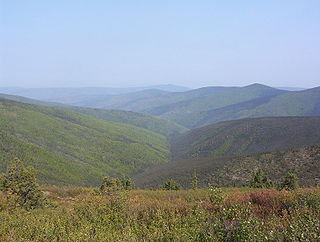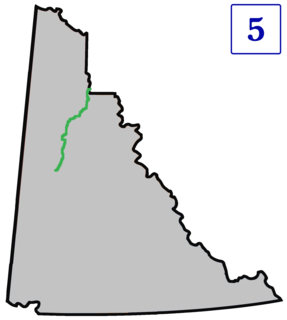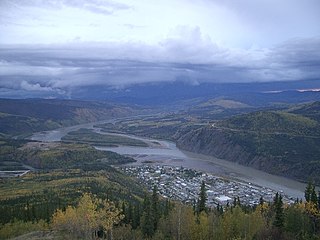Related Research Articles

The Klondike is a region of the Yukon territory in northwest Canada, east of the Alaskan border. It lies around the Klondike River, a small river that enters the Yukon River from the east at Dawson City. The area is merely an informal geographic region, and has no function to the territory as any kind of administrative region.

Yukon is the smallest and westernmost of Canada's three territories. It also is the least populated province or territory in Canada, with a population of 35,874 people as of the 2016 Census. Whitehorse, the territorial capital, is the largest settlement in any of the three territories.

The Klondike Gold Rush was a migration by an estimated 100,000 prospectors to the Klondike region of the Yukon, in north-western Canada, between 1896 and 1899. Gold was discovered there by local miners on August 16, 1896; when news reached Seattle and San Francisco the following year, it triggered a stampede of prospectors. Some became wealthy, but the majority went in vain. It has been immortalized in films, literature, and photographs.

Dawson City, officially the City of Dawson, is a town in the Canadian territory of Yukon. It is inseparably linked to the Klondike Gold Rush (1896–99). Its population was 1,375 as of the 2016 census, making it the second-largest town in Yukon.

The Dempster Highway, also referred to as Yukon Highway 5 and Northwest Territories Highway 8, is a highway in Canada that connects the Klondike Highway in Yukon to Inuvik, Northwest Territories on the Mackenzie River delta. The highway crosses the Peel River and the Mackenzie Rivers using a combination of seasonal ferry service and ice bridges. Year-round road access from Inuvik to Tuktoyaktuk opened in November 2017 with the completion of the Inuvik-Tuktoyaktuk Highway, creating the first all-weather road route, connecting to the Canadian road network with the Arctic Ocean, in Canada.

Klondike Gold Rush National Historical Park is a national historical park operated by the National Park Service that seeks to commemorate the Klondike Gold Rush of the late 1890s. Though the gold fields that were the ultimate goal of the stampeders lay in the Yukon Territory, the park comprises staging areas for the trek there and the routes leading in its direction. There are four units, including three in Municipality of Skagway Borough, Alaska and a fourth in the Pioneer Square National Historic District in Seattle, Washington.

Carmacks is a village in Yukon, Canada, on the Yukon River along the Klondike Highway, and at the west end of the Robert Campbell Highway from Watson Lake. The population is 493. It is the home of the Little Salmon/Carmacks First Nation, a Northern Tutchone-speaking people.
Klondike may refer to:

The Trʼondëk Hwëchʼin is a First Nation band government located in the Canadian territory, Yukon. Its main population centre is Dawson City, Yukon.

Forty Mile is best known as the oldest town in Canada’s Yukon. It was established in 1886 at the confluence of the Yukon and Fortymile rivers by prospectors and fortune hunters in search of gold. Largely abandoned during the nearby Klondike Gold Rush, the town site continued to be used by Tr’ondëk Hwëch’in. It is currently a historic site that is co-owned and co-managed by Tr’ondëk Hwëch’in and the Government of Yukon.

Tr'ochëk is the site of a traditional Hän fishing camp at the confluence of the Klondike River and Yukon River. The site is owned and managed by the Tr’ondëk Hwëch’in First Nation, and is operated by the First Nation's Department of Heritage.

Klondike Fever is a 1980 Canadian adventure film, based on the writings of Jack London. It follows London's journey from San Francisco to the Klondike gold fields of the Yukon Territory, Canada in 1898.

The Skagway Historic District and White Pass is a National Historic Landmark District encompassing a significant portion of the area within the United States associated with the Klondike Gold Rush. It includes the historic portion of Skagway, Alaska, including the entire road grid of the 1897 town, as well as the entire valley on the United States side of White Pass all the way to the Canada–US border. This area includes surviving fragments of three historic routes used during the Gold Rush, as well as the route of the White Pass and Yukon Railroad. Almost 100 buildings remain from the Gold Rush period. Portions of the district are preserved as part of Klondike Gold Rush National Historical Park.

The Chilkoot Trail and Dyea Site is a National Historic Landmark district comprising the Chilkoot Trail and the former town of Dyea, Alaska. They are contained in the Klondike Gold Rush National Historical Park which preserves the historic buildings and locations connected to the Klondike Gold Rush period of Alaskan history. For a brief period between 1897 and 1899, this trail and town were full of prospectors. By 1905, most of the buildings had been demolished or removed. Both the trail and the town site are part of the Klondike Gold Rush National Historical Park.

The Yukon School of Visual Arts (SOVA) is Canada's most northerly post-secondary fine arts school, and it receives its accreditation through the Applied Arts Division of Yukon College. SOVA is located within the traditional territory of the Tr'ondëk Hwëch'in First Nation in Dawson City, Yukon Territory, Canada. SOVA offers a Foundation Year Program, which is the equivalent of the first year of a Bachelor of Fine Arts (BFA) degree. The school offers an experimental, integrated curriculum that is studio-based with liberal arts courses. Successful students continue their degrees at their choice of five partnering art schools across Canada, including the Ontario College of Art and Design in Toronto, the Emily Carr Institute of Art and Design in Vancouver, the Alberta College of Art and Design in Calgary, Mount Allison University in Sackville, NB and the Nova Scotia College of Art and Design University in Halifax.

The Stewart River is a 533-kilometre (331 mi) tributary of Yukon River in the Yukon Territory of Canada. It originates in the Selwyn Mountains, which stand on the border between the Northwest Territories and the Yukon Territory. From there, the Stewart flows west, past the village of Mayo. The river is crossed by the Klondike Highway at the village of Stewart Crossing, and the highway parallels the river westward for about 56 kilometres (35 mi). After leaving the highway, the river travels southwest until it intersects the Yukon River 112 kilometres (70 mi) south of Dawson City. The mostly abandoned village of Stewart River is located at the mouth of the river.
Diamond Tooth Lil was an American cultural figure popular in the early 20th century as an icon of wealth and libertine burlesque. Several individuals called themselves "Diamond Lil" or "Diamond Tooth", creating an amalgamated legacy clouded by myth. These individuals include a vaudeville entertainer in the Yukon during the 1890s Klondike Gold Rush, a madam in the American West during the early 1900s, and the titular character of Mae West's Diamond Lil, who embodied these traits and popularized the name in the 1920s.

The SS Keno is a preserved historic sternwheel paddle steamer and National Historic Site of Canada. The SS Keno is berthed in a dry dock on the waterfront of the Yukon River in Dawson City, Yukon, Canada.

The Yukon Hotel is a National Historic Site of Canada and part of the Dawson Historical Complex. It is a log building with a three-storey false facade on First Avenue at the corner of Church Street in Dawson City, Yukon.

Discovery Claim is a mining claim at Bonanza Creek, a watercourse in the Yukon, Canada. It is the site where, in the afternoon of August 16, 1896, the first piece of gold was found in the Yukon by prospectors. The site is considered to be the place where the Klondike gold rush started. It is located around 17 km south-southeast of Dawson City. The Discovery claim was designated a National Historic Site of Canada on July 13, 1998.
References
- ↑ anonymous. "Diamond Tooth Gerties Gambling Hall". travelyukon.com. Archived from the original on 2014-02-14.
- ↑ Dawson City. "History of Diamond Tooth Gerties Gambling Hall". DawsonCity.ca.
- ↑ Dan Davidson. "Gerties is now a Municipal Heritage site". Whats Up Yukon.
- ↑ Yukon Register of Historic Places. "The Arctic Brotherhood Hall municipal historic site is a two storey frame building located at the corner of Queen Street and Fourth Avenue, Lots 1 and 2, Block S, Ladue Estate, in Dawson City". Yukon Register of Historic Places.
- ↑ Players Poker Canada. "About Diamond Tooth Gerties". Players Poker Canada.
- ↑ Casino City. "Diamond Tooth Gertie's Gambling Hall". CasinoCity.com.
- ↑ Dawson City. "Games of Chance". DawsonCity.ca.